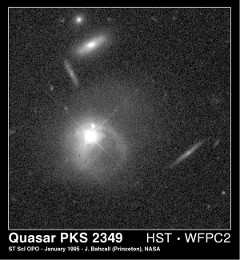Quasar and Companion Galaxy: The bright central object is a quasar that is merging with its companion galaxy.
Credit: John Bahcall (Institute for Advanced Study, Princeton University), NASA
Rich had found quasars in lots of different places and he wanted to find the largest possible number of these extragalactic point sources. And to do what he needed to do you needed a survey of a large part of the sky. Something way beyond anything that had been done. We now know that the survey would increase the number of known quasars by over 100 times. The survey would also allow us to discover how to find them all, so now all we have to do is look for them with the right techniques.
Jim, too, had lots of questions about astronomical objects. He had spent his career working on clusters of galaxies, but had addressed many fields in astronomy. I think he knew that if one carried out a large survey like SDSS (not a common way to do astronomy at the time) with a medium-sized modern telescope you would just find all sorts of new things because the Universe is what it is. And our picture of the Universe is what it is. There is no reason to think we have the complete story. We don’t know enough about different kinds of astronomical objects to project what things would be there if we looked in a different wave band for instance. You just have to explore to find that.
I was interested in working with those two very talented smart people, but the biggest push for me was more philosophical, I wanted to know exactly what is out there. This dovetails nicely with Rich and Jim’s motivations.
Distant Galaxy Clusters: One of Hubble's early images reveals about 30 compact objects that are among the faintest (oldest) galaxies observed at the time (in 1992).
Credit: Alan Dressler, Carnegie Institution, and NASA Co-Investigators: Augustus Oemler (Yale University), James E. Gunn (Princeton University), Harvey Butcher (the Netherlands Foundation for Research in Astronomy)



